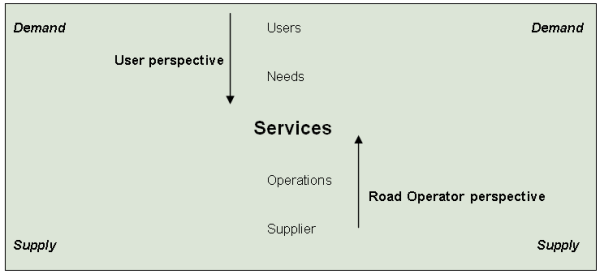
Road Network Operations
& Intelligent Transport Systems
A guide for practitioners!

Road Network Operations
& Intelligent Transport Systems
A guide for practitioners!
The Road Network Operations concept puts the needs of road users and their travel expectation ahead of any institutional requirements. In this respect road users – private individuals and businesses - can be likened to customers who are concerned with factors that affect their economic well-being and the convenience of every-day living. As regards roads and traffic, most likely they will be preoccupied with issues that concern ease of mobility and accessibility and the reliability of their journeys. (See Users of ITS)
Their expectations may include:
Serving road users is fundamental to network operations. The network operator’s aim is to ensure acceptance and compliance with any measures taken to balance the supply of road space with the traffic demand. As more sophisticated ITS-based services are deployed, gaining end user acceptance and building trust is even more important. The more that users understand the reasons for traffic regulation and trust the information provided the better the services will operate for all stakeholders.
The principle of “customer orientation” is a major challenge. (See Road User Services) The attitude and behaviour of road users is critical to the success of network operations. Users can be the general public, commercial enterprises, businesses, road haulage firms and professional drivers, with a wide diversity of needs and requirements. The network operating strategies that are adopted may need promotion and do not always receive popular support. Procedures and protocols have to be reviewed and adapted with the objective of service to the user firmly in mind. Systems should be designed to allow road users to make informed travel choices and achieve easy compliance with traffic regulations.
In general the road user looks to road operator to provide the facilities to make their journeys safe, efficient and reliable. As the road user would see it, network operations exist to ensure the roadway is available to a level of service that will allow the user to meet his or her objectives. From this perspective road network operations consist of the processes and provisions that are needed to deliver that service.
The road operator has a somewhat different perspective. The primary concern of is to keep the road open and safe for the level of traffic that the roadway is designed to carry, which at times may be a lot less than the traffic demand. In practice public expectations and political pressure means doing much more than this. From the road operator’s perspective the mission of network operations is to develop and implement the measures and processes that are necessary to achieve the wider goals set by the community.
These two different perspectives can be summarised in the diagram below.

In the diagram users and their needs are in the travel demand domain, while the road operators and road user service suppliers are in the roadway supply domain. RNO activities and ITS-based services are positioned between the two.
In general, user services are there to support something the user wants to do, in this case use the road for moving people or goods. (See Traveller Services and Freight & Delivery Operations) In the model of the two perspectives, that of the user and that of the road operator, the services that are delivered directly to the user are the “front-office” services. These are tangible and are immediately perceived by the user. The “back-office” services (related to technical systems and control centres, for example) are part of road operator’s view.
It is worth noting that road users, the network operators and their suppliers are all well-defined entities whereas needs and services are more abstract in nature. This makes dealing with user services very different from basic road maintenance operations, which are an established part of the road owner’s responsibility. The quality of services is heavily dependent on the way users perceive and appreciate those services. That is the main reason why dealing with services to support road users requires a different approach from dealing with the practicality of operating the technical systems.
In summary, integrated network operations need to be customer-oriented: in other words, oriented towards the groups and classes of users who have a direct interest in the specific road network.
As a general rule, a service-orientated approach is required, in contrast to a more traditional focus on road construction and maintenance. Systems are there to serve the needs of end users, not vice-versa. This principle applies to conventional tasks such as the organisation of road-works, the design of the signing, emergency call-out procedures and also to more sophisticated network operations activities, such as traffic control or demand management.